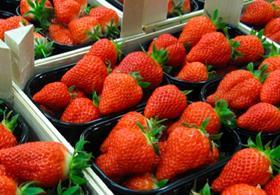
Soft fruit continues to be one of the fresh produce sector’s glory categories.
Adam Olins, MD of soft-fruit giant BerryWorld, lets the figures do the talking: “The UK soft-fruit category grew 17 per cent last year and during the first few months of 2016 has continued to see further growth, and we believe this has been mirrored throughout Europe,” he says. “In the UK, the soft-fruit market has now surpassed £1 billion, and is being driven by significant increases in purchase frequency, up 10 per cent across 2015, versus 2014. Penetration is also growing, and has now hit 82.5 per cent.”
The latest Kantar Worldpanel data broadly aligns with Olins’ figures, further illuminating the rosy outlook for the berry category. Nevertheless, like everyone else in this industry, growers are still at the mercy of the weather, and Olins notes that while demand is very strong, “supply is relatively short across all products as we head towards Easter.”
In particular, Spain has proved challenging. Pascal Simian, director at Berry Alliance, an Evesham-headquartered not-for-profit company set up to support growers throughout the world supply directly to retailers in the UK, says: “The weather in Spain has been playing havoc, with the season starting much earlier than expected, followed by cold, wet weather that is causing the offer to be weak compared to the current demand. Also, as nearly 50 per cent of the plantation in Huelva has been with early varieties, we may still see a continued deficit of offer for the late part of the season.”
Mamen Sanchez, berry breeding giant EMCO CAL’s representative in Spain and Morocco, adds: “The current season has been characterised by high temperatures until the month of December, which resulted in high yields very early in the season. Prices then fell over the winter holidays.
“During January to the third week of February, the high humidity caused some problems in fruit quality, mainly due to botrytis. A large number of fruit had to be discarded, and offset the fruit surplus in the market. Prices consequently stabilised. At present, the low night temperatures have slowed strawberry production, and the wind has decreased humidity. These climatic factors jointly contributed to an improved fruit quality.”
From the field to the shelves, and the UK retailers’ war on price hasn’t steered clear of the berry category, which is also witnessing changes to the traditional supply model. Olins says: “Undeniably the discounters are having a significant effect in growing the overall category by bringing in new customers. The main retailers have responded in various different ways, but the combined result has seen more people buying berries, which is always positive and can be proven by the growth seen in soft fruit last year.”
Simian adds: “The market is still growing at a rate of 13 to 15 per cent year on year, so this is positive. Supermarkets are aiming more and more to create direct links with growers so they can competitively price and protect margins. The main effect is the remodeling and change of the supply chain. This is not always as easy as it looks.
“Development of variety in strawberries and raspberries is having an impact. Resealable packaging and snack pots present an opportunity too. In these times of price war, points of difference and added convenience to the consumer is a way to drive value in the category.”
Finding such points of difference remains the holy grail. Michael Jarvis, head of marketing at Scottish berry brand Scotty Brand, says: “New berry varieties are being developed quickly, and are commercially available to retailers. This is good, as it gives greater choice to consumers, but it can also lead to confusion.”
Sanchez foresees that “consolidation of the diversification of other berries will increase profitability and diversify risks”. Looking into what’s on the horizon a few years down the line, she says she expects growers will further expand the production cycle, trying to produce year round, while also diversifying into other crops, looking for varieties that cover wider production windows, and also searching for new export markets.
For Simian, meanwhile, transparency from field to shelf will be the biggest change in the category over the next five to 10 years. He says: “As an industry, in order for all stakeholders to be able to earn a decent return, the supply chain has to be made clear and transparent so that the cost of each operation can be quantified and justified.
“It’s not all about just taking the cost out; it’s about ensuring the essential costs – those that deliver value for money – are not jeopardised. The last thing we need is to create a ‘cheap’ supply chain that fails to deliver service and quality to the consumer.”
The Global Berry Congress is taking place this week, 14-16 March, in Rotterdam. Follow @berrycongress for conference updates.



